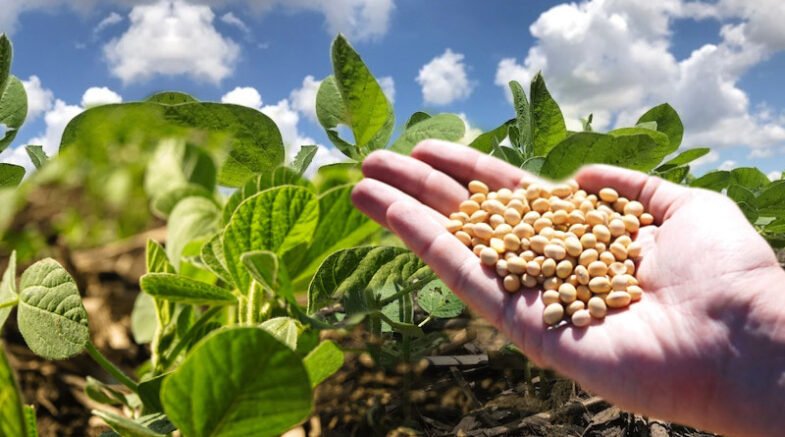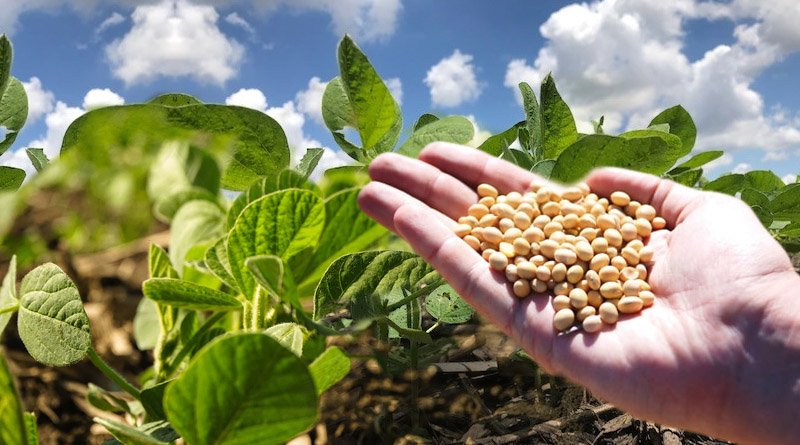Soybean (Glycine max) is a species of legume that is widely cultivated for its edible beans, which are a rich source of protein and oil.

Soybean, due to its multiple uses and multi benefits is called the pearl of nutrition . Soybean is the rising crop of this era. Considering the importance of soybeans, it is necessary to work on improving soybeans.
Soybean (Glycine max) is a species of legume that is widely cultivated for its edible beans, which are a rich source of protein and oil. It is native to East Asia, but has been introduced to many other parts of the world and is now grown on every continent except Antarctica.
Soybean, the pearl of nutrition, is an important crop for food and feed production. It is used to make a variety of products including soy milk, tofu, soy sauce, and vegetable oil. Soybean meal, the by-product of oil extraction, is a valuable source of protein for animal feed. The cultivation of soybeans began thousands of years ago in China and Korea.
It was introduced to Japan in the 6th century and later to other parts of Asia. Soybean was first introduced to Europe in the 18th century and to the United States in the late 1700s. Today, the United States is the largest producer of soybean, followed by Brazil and Argentina.
Soybean breeding purposes.
Soybeans are typically bred for a variety of purposes, depending on the needs of growers and end-users. Some common breeding objectives for soybeans include:
Yield improvement: Breeders work to develop soybean varieties that produce higher yields, which can increase profits for growers.
Disease resistance: Soybean varieties are bred to resist diseases such as soybean rust, bacterial blight, and stem canker. This reduces crop losses and the need for chemical treatments.
Pest resistance: Soybean varieties are bred to resist pests such as aphids and soybean cyst nematodes, reducing crop losses and the need for chemical treatments.
Improved nutritional value: Soybean varieties are bred to have higher levels of specific nutrients such as protein, oil, and amino acids, making them more desirable for use in animal feed and food products.
Environmental adaptation: Soybean varieties are bred to adapt to specific environments, such as drought-prone regions or areas with specific soil types, to improve yields and reduce crop losses. Overall the breeding of soybeans is aimed at improving crop performance, reducing crop losses, and providing products that meet the needs of different markets.
Soybean Nutrition Facts.
Soybeans are a good source of plant-based protein and are rich in essential nutrients. Here are some key nutritional facts about soybeans:
High in protein: Soybeans are one of the few plant-based sources of complete protein, which means they contain all nine essential amino acids.
Rich in fiber: Soybeans are high in both soluble and insoluble fiber, which helps to promote digestive health, lower cholesterol levels, and reduce the risk of chronic diseases.
Low in saturated fat: Soybeans are a good source of healthy fats, including polyunsaturated and monounsaturated fats, which can help to reduce the risk of heart disease.
Contains isoflavones: Soybeans are one of the best dietary sources of isoflavones, a type of phytoestrogen that may help to reduce the risk of breast cancer and other hormone-related cancers.
Versatile ingredient: Soybeans can be used in a variety of different dishes, including tofu, soy milk, and tempeh, making it a versatile ingredient for those following a vegetarian or vegan diet.
It’s important to note that while soybeans can be a healthy addition to a balanced diet, they should not be relied on as the sole source of nutrition. It’s important to consume a variety of different foods to ensure that you are getting all of the essential nutrients your body needs.
Role of soybeans in medicinal field
Soybeans have been used for medicinal purposes for thousands of years in traditional medicine practices in East Asia. The various parts of the soybean plant, including the beans, leaves, and roots, have been used to treat a wide range of health conditions.
Soybeans contain phytoestrogens and isoflavones, which have been studied for their potential health benefits. These isoflavones may have estrogen-like effects on the body and are being studied for their potential role in treating or preventing conditions such as osteoporosis, menopausal symptoms, and some types of cancer.
Soybean oil is also used in traditional medicine for its potential health benefits. It is rich in vitamin E and essential fatty acids, which may help to promote healthy skin and hair, reduce inflammation, and lower cholesterol levels.
Some studies have also suggested that soybeans and soybean products may have potential health benefits for heart health, brain function, and weight management. However, more research is needed to confirm these potential benefits and to determine the appropriate dosages and forms of soybeans for medicinal use.
It is important to note that while soybeans and soy products are generally considered safe for most people when consumed in moderation as part of a balanced diet, they may not be suitable for everyone. People with soy allergies or thyroid conditions should speak with their healthcare provider before using soybean products for medicinal purposes.
Pakistan facing problems and their solution to adopt soybean
As far as I am aware, soybean cultivation and adoption is not a major issue in Pakistan, but there could be some challenges faced by farmers or policymakers in promoting soybean cultivation in the country. Some of these challenges could include:
Limited knowledge and awareness: Lack of knowledge and awareness about the benefits of soybean cultivation, its potential as a cash crop, and its nutritional value may hinder its adoption.
Limited research and development: Limited research and development on soybean cultivation, including development of high-yield, disease-resistant varieties, may limit its potential in Pakistan.
Limited infrastructure: Limited infrastructure for processing and marketing of soybeans may also hinder its adoption.
Competition with other crops: Soybean cultivation may face competition with other crops that are already established in Pakistan, such as cotton, wheat, and rice.
Climate and environmental factors: The suitability of soybean cultivation in certain regions of Pakistan may be affected by climate and environmental factors, such as water availability and soil quality.
Overall, while cultivation of soybean, pearl of nutrition may not be a major issue in Pakistan, there could be some challenges that need to be addressed in order to promote its adoption and ensure its success as a cash crop.
How to overcome the low adaptation of soybeans in Pakistan
There are several strategies that can be used to overcome the low adaptation of soybeans in Pakistan:
Select suitable soybean varieties: Selecting varieties of pearl of nutrition soybean that are adapted to the local growing conditions in Pakistan can help to increase the crop’s yield and resilience to pests and diseases. It’s important to choose varieties that have good germination rates and resistance to heat and drought.
Optimize planting time: Soybean, a pearl of nutrition, is sensitive to temperature and photoperiod, so it’s important to plant them at the right time. In Pakistan, the best time to plant soybeans is between April and May, when temperatures are warm but not too hot.
Improve soil fertility: Soybeans require well-drained, nutrient-rich soil to thrive. In Pakistan, where soils are often nutrient-deficient, it’s important to add fertilizers and organic matter to the soil to improve its fertility.
Control pests and diseases: Soybean, pearl Of nutrition in Pakistan is susceptible to a range of pests and diseases, including pod borer, aphids, and rust. It’s important to implement pest and disease management strategies, such as crop rotation, use of resistant varieties, and timely application of pesticides.
Increase awareness and knowledge: Raising awareness among farmers and agricultural extension workers about the benefits and potential of soybean cultivation can help to increase adoption of the crop.
Providing training and information on best practices for cultivation, pest and disease management, and market opportunities can help to increase soybean production and profitability in Pakistan.
How soybeans can play role in Pakistan economy
Soybeans can potentially play an important role in the Pakistani economy in several ways:
Increasing agricultural productivity: Soybean cultivation can help increase the productivity of Pakistan’s agricultural sector. Soybeans can be grown as a rotation crop with other crops, which can help replenish the soil with essential nutrients and improve overall soil health.
Diversification of crops: Soybean cultivation can help diversify Pakistan’s agricultural crops, which can reduce the country’s dependence on traditional crops like wheat, rice, and cotton. This diversification can help reduce the risk of crop failure due to pests, diseases, and weather patterns.
Generating income: Soybean cultivation can provide farmers with an additional source of income. Soybeans can be sold domestically or exported to other countries, providing farmers with a new market for their produce.
Improving food security: Soybeans can be used to produce a range of food products, including soy milk, tofu, and other soy-based foods. These products can provide a nutritious source of protein for the Pakistani population, particularly for those who cannot afford more expensive sources of protein.
Supporting the livestock industry: Soybean meal is a common feed ingredient for livestock, including poultry, pigs, and cattle. Increased soybean cultivation can help support Pakistan’s growing livestock industry, which can help boost the country’s overall economic growth.
Soybean cultivation can provide numerous benefits to the Pakistani economy, including increased agricultural productivity, diversification of crops, generating income for farmers, improving food security, and supporting the livestock industry.
This article is jointly authored by Muhammad Qamar and Dr.Humera Razaq. 